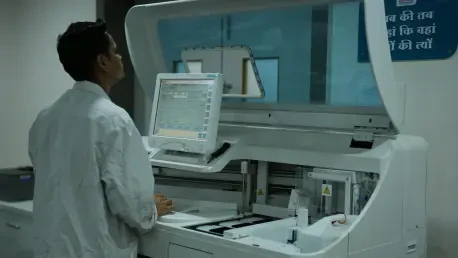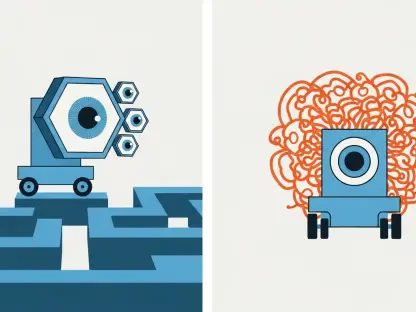Imagine a world where the mundane, repetitive tasks that bog down industries like healthcare are handled effortlessly by intelligent systems, freeing up human resources for more critical, life-saving work. In an era where administrative inefficiencies cost sectors like healthcare over $1 trillion annually, according to McKinsey reports, the need for a revolutionary approach to automation has never been more urgent. Traditional tools, long relied upon to streamline processes, are faltering under the weight of modern challenges such as unstructured data and dynamic workflows. A new player has emerged on the scene, promising to redefine how automation is approached with cutting-edge AI technology. This shift could potentially transform not just one industry, but multiple sectors struggling with similar burdens, sparking curiosity about whether this innovation is the key to unlocking a new era of efficiency.
Challenges of Traditional Automation Tools
Limitations in a Dynamic Environment
The landscape of process automation has long been dominated by Robotic Process Automation (RPA) platforms that automate repetitive tasks through digital bots mimicking human actions like keystrokes and clicks. While these systems have generated billions in revenue for companies, their rigidity poses significant challenges in today’s fast-evolving environments. Industry estimates suggest that traditional RPA fails in over 30% of cases due to its inability to adapt to complexities like unstructured data from PDFs, emails, and images, as well as ever-changing user interfaces. This lack of flexibility often results in disrupted workflows, especially in industries where adaptability is crucial. The reliance on scripted, rule-based actions means that even minor deviations from the expected can lead to costly errors, leaving businesses scrambling for solutions that can keep pace with modern demands and ensure seamless operations across diverse systems.
Industry-Specific Struggles and Shortfalls
Healthcare, in particular, highlights the shortcomings of legacy RPA, where administrative processes alone account for a staggering quarter of the total market expenditure. With over 30% of RPA revenue coming from this sector, the technology was expected to alleviate burdens like delayed care and rising costs driven by staff shortages and burnout. However, fragmented systems, messy workflows, and the prevalence of unstructured data have proven too much for traditional tools to handle effectively. The inability to integrate smoothly with existing infrastructures or manage the nuances of patient-related data has left many healthcare providers frustrated. As administrative inefficiencies continue to escalate, the call for a more robust, adaptable solution grows louder, pushing the boundaries of what automation must achieve to truly transform an industry under immense pressure to deliver timely and accurate services.
The Rise of AI-Driven Solutions
Introducing a New Automation Paradigm
Amid the struggles of traditional automation, a groundbreaking platform has emerged, leveraging advanced AI to tackle the very issues that have plagued legacy systems. This innovative solution focuses on understanding context, intent, and documents, setting itself apart from the rigid, script-based approaches of the past. In healthcare, where it has already made significant inroads, the platform automates critical front-office tasks such as patient intake, eligibility verification, and prior authorizations. Its ability to integrate seamlessly with Electronic Health Records (EHRs) while adhering to stringent compliance standards like HIPAA ensures that sensitive data is handled with precision. Within a short span, this technology has processed over 500,000 patients monthly across various providers, demonstrating its potential to address long-standing inefficiencies with a user-friendly interface that offers transparency in every action and output.
Expanding Horizons Across Sectors
The success in healthcare serves as a powerful indicator of the broader potential for AI-driven automation to revolutionize other industries facing similar administrative challenges. Sectors like banking, insurance, and logistics, which also grapple with complex workflows and unstructured data, stand to benefit from a technology that can manage end-to-end tasks with intelligence and adaptability. The transition from brittle, script-dependent tools to AI-native solutions represents a pivotal trend in automation, promising to redefine operational efficiency on a global scale. Backed by visionary founders with deep expertise in AI and scalable systems, this platform’s clarity of purpose and ambition suggest a future where administrative burdens are significantly reduced. As more industries take notice, the implications of this shift could reshape how businesses approach process management, paving the way for smarter, more flexible technologies.
Looking Ahead to Smarter Automation
Reflecting on a Transformative Shift
The journey from traditional RPA to AI-powered platforms marks a significant turning point in how industries address operational inefficiencies. The struggles of legacy tools, which often faltered in the face of unstructured data and dynamic environments, underscored the necessity for innovation. In response, a new wave of technology demonstrated its prowess by tackling complex challenges head-on, particularly in high-stakes sectors like healthcare. By processing vast numbers of patient interactions with precision and transparency, this solution proved that automation could evolve beyond mere repetition to genuine understanding. Looking back, the clarity of vision behind this advancement stood out as a driving force, highlighting the potential for technology to adapt and thrive in even the most demanding circumstances.
Envisioning Broader Impact and Solutions
As the impact of AI-driven automation ripples outward, the focus shifts to actionable steps for scaling its benefits across diverse fields. Industries burdened by administrative complexities are beginning to explore how to integrate such technologies to streamline operations and reduce costs. The next phase involves fostering collaboration between technology developers and sector leaders to tailor solutions that address specific pain points, from compliance hurdles to workflow bottlenecks. Encouraging pilot programs in areas like banking and logistics emerges as a practical approach to test adaptability and refine capabilities. Beyond immediate applications, the emphasis rests on building frameworks that ensure long-term scalability and resilience, setting a foundation for automation to evolve alongside industry needs. This forward-thinking mindset promises to unlock unprecedented efficiency, transforming challenges into opportunities for growth and innovation.









